The decision to spay or neuter your Great Dane is a big one for owners. With the exception of experienced breeders, most families will opt to have their Great Danes altered.
The term “altered” refers to the process of spaying or neutering. Because many people feel a little bit of guilt about the decision to spay or neuter their Dane, let’s cover the long list of health benefits.
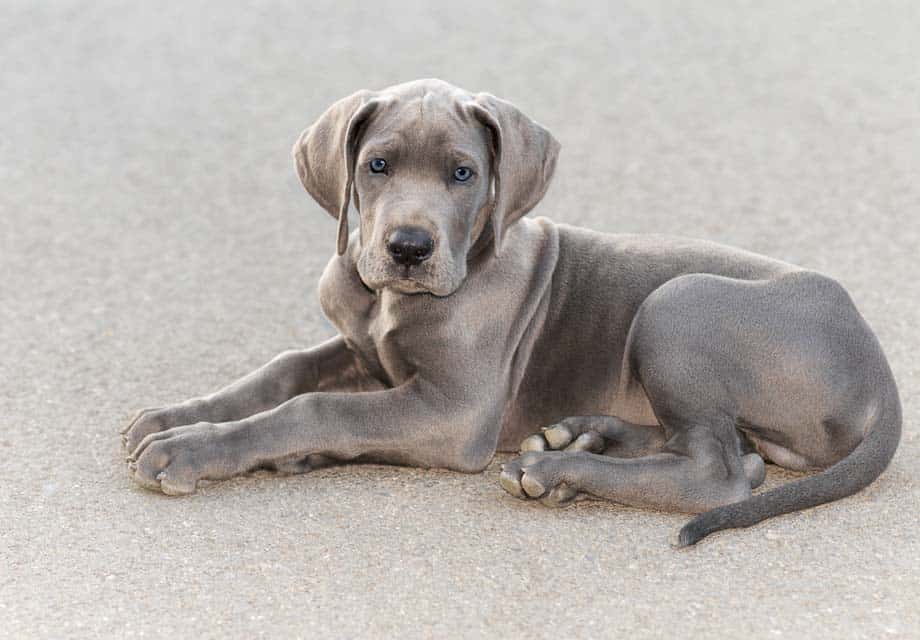
When is the Best Time to Spay or Neuter?
General advice can be confusing because smaller breeds can perform these surgeries as early as a few months of age.
However, research and anecdotal evidence indicate that spaying or neutering Great Danes too soon is detrimental to their long-term health.
Great Danes grow at an incredible rate in the first year of life. By postponing this procedure you give their bodies the necessary time to develop. This includes physical and hormonal development; the latter being especially important.
When to Neuter a Male Great Dane
For males, this means that neutering should not be conducted until they are at least one year of age.
This ensures that they have a chance to fully develop the musculature needed to support their massive frames.
Otherwise, they may have the appearance of a gangly puppy their entire life (not a good thing).
When to Spay a Female Great Dane
Female Great Danes should not be spayed until they are at least one year old. However, they should also be allowed to experience their first heat as well.
Because the risk of clots due to elevated hormones is much higher around the heat, allow for 2 months after the conclusion of a heat before performing the spay surgery.
In the event that their first heat arrives before they are one year in age, the spay should be delayed until they are at least one year in age.
When discussing a spay with your veterinarian, some may recommend performing the spay closer to 9 months in age in order to prevent them from experiencing their first heat. While general studies have found that spaying prior to a first heat does reduce the risk of mammary cancer, they do not take into account the elongated growth patterns of Great Danes.
These studies are performed with primarily small and medium sized dog breeds, and therefore are not representative of giant breeds like Great Danes. While the risk of cancer is certainly real, so is the risk of orthopedic developmental issues.
Due to the severity of these developmental issues caused by early spaying, many Great Dane breeders go as far as to require that dogs from their litters not be spayed until a later age even given the risk of mammary cancer.
For more Great Dane specific information, make sure to take a look at my book “The Great Dane Puppy Handbook” that covers everything that you need to know about caring for a Great Dane!
The Great Dane Puppy Handbook takes all of the need-to-know Great Dane info and packages it together into a single, concise resource. Save yourself time, money, and frustration by avoiding the most common mistakes made by Great Dane owners!
Why Should I Spay or Neuter My Great Dane?
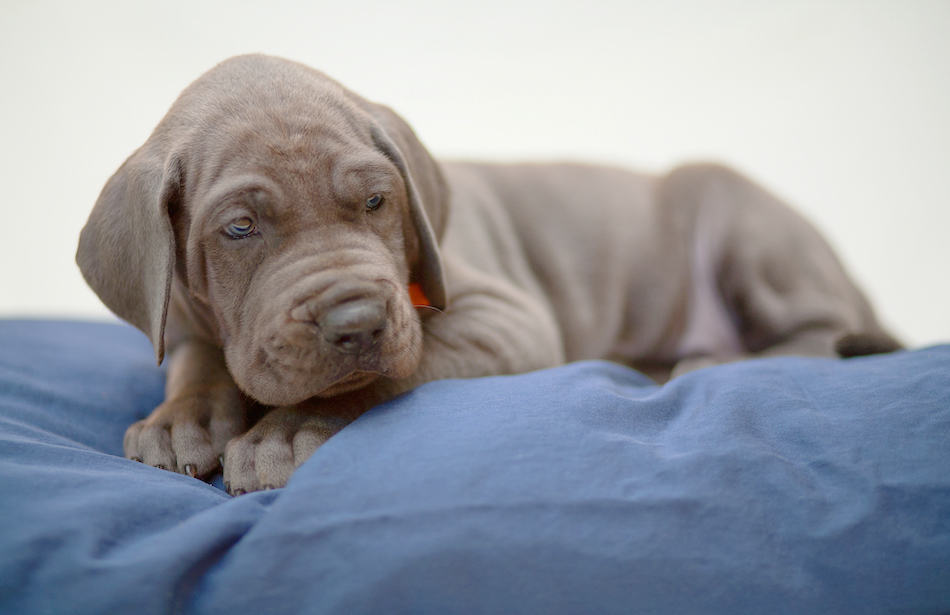
As you will see below, there is a long list of reasons why you should consider spaying or neutering your Great Dane.
The one scenario where it is clearly not the right option is intentional breeding.
Breeding is a massive responsibility and should not be taken lightly. As this article is not focused on breeding, I will leave it at that!
Health Benefits
According to the 2013 State of Pet Health Report released by Banfield Pet Hospital, altered pets live longer than those that remain intact!
In fact, neutered males lived 18% longer on average than unneutered males. This is largely attributed to the prevention of testicular cancer and prostate problems.
By comparison, females who have been spayed live a whopping 23% longer on average than those that are not spayed!
Avoidance of ovarian cancer and uterine infections are the primary benefits leading to the increase.
Given the already abbreviated lifespan of Great Danes, these kinds of numbers are pure magic!
Behavioral Implications
Aggression
Intact animals are far more likely to display acts of aggression, dominance, and territorial behavior compared to those who are not. In fact, studies have shown that most dogs bite incidents involve those who are unaltered.
While bites are the worst case, displays of dominance can also manifest in acts such as excessive barking and mounting.
Neutering will lower the overall testosterone in males and should help resolve undesirable behaviors but is not a guaranteed fix.
Habitual behaviors can be hard to break, and the outcome will also depend upon the dog’s physiology and history.
Roaming
“Houdini Syndrome” is real!
Ok, I may have made up that name, but dogs have proven to be incredibly resourceful when it comes to escaping from backyards and other enclosures.
Given the massive size and weight of Danes, you are going to be hard-pressed to construct something strong enough to hold them back if they really want to get out.
This is often due to their desire to seek out females in heat, who they may have detected while on a previous walk. On their own, they risk getting injured by cars or potentially fights with other males.
Should you succeed in barricading them in, there is still the risk of injury to the dog or simply destruction of whatever you built to hold them back.
Urine-marking
Have you ever seen a dog running around peeing on everything in sight?
This behavioral stunt is referred to as urine-marking and can be exhibited by both male and female dogs.
This is considered a territorial maneuver, in which the animal is staking their claim on areas or object to claim as their own.
Spaying or neutering your Dane should reduce urine-marking, or potentially stop it altogether.
Save Money!
- While there is an up-front cost to a spay or neuter, it can potentially save you far more down the road. Care for infections or uterine cancer can run five to ten times more than the cost of a spay.
- The cost of caring for a litter will exceed the cost of a spay or neuter.
- Statistics show that unaltered pets are involved in more aggressive behavior such as fighting which can also contribute to veterinary bills.
- Depending on the county in which you live there may also be costs associated with the licensing and renewal of an unaltered pet.
- Many boarders and daycares will not accept unaltered males due to the added risk of aggressive behavior. Females in heat will almost certainly not be admitted, forcing you to find an alternate solution (few of which exist).
Reduce Orphaned Pets
This is a very sad topic to bring up, but every year there 6-8 million homeless animals admitted to animal shelters just in the United States alone according to the Humane Society.
Tragically, less than half of these animals are adopted, and the remaining ones are euthanized. The majority of these animals are healthy and would make fantastic companions, but there just aren’t enough resources to support them.
Unfortunately, the majority of these animals are the offspring of family pets. While most pet owners are not intentionally negligent, it just goes to show how hard it is to control the desire to breed.
While there are forms of pet birth control for females, they are not recommended very often due to risks. The risk of complications from surgery is extremely low by comparison.
It also provides a 100% guaranteed method that accidental litters will not be produced.
The timing of spay and neuter procedures for Great Danes is just one of the specifics to caring for this giant breed dog. For a single simple resource that covers all of these need to know puppy details, make sure to take a look at The Great Dane Puppy Handbook.
What Happens in Surgery?
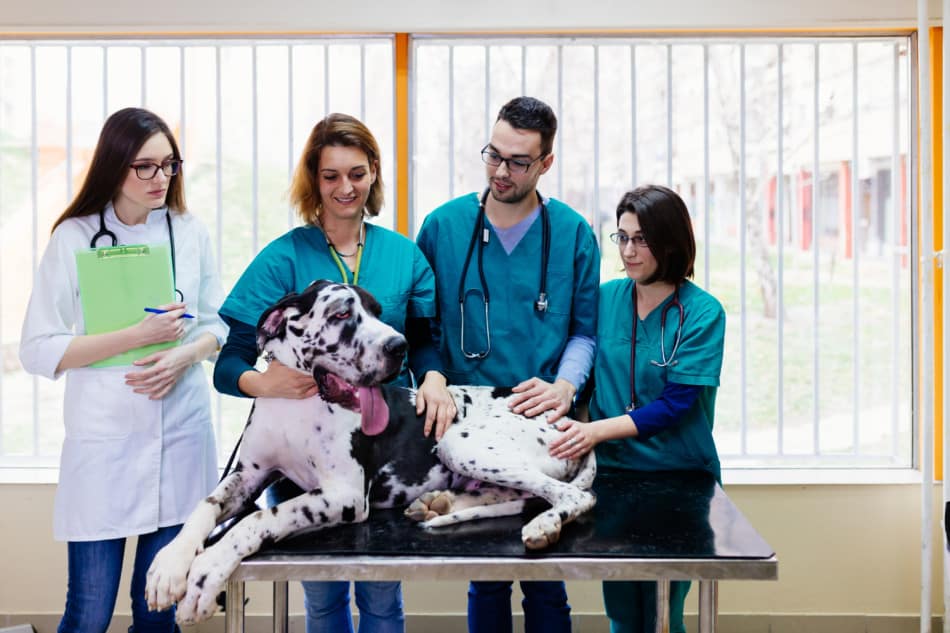
The Great Dane Club of America has put out a very comprehensive guide detailing care during and after surgery. Rather than duplicate their material, I’m simply going to link to it here for your reference.
I will briefly mention two of the most important items for in-surgery care below:
- Support the dog’s neck at all times. While under anesthesia they are not able to support themselves and can result in damage to the spine.
- During and after surgery they are extremely susceptible to hypothermia. The use of heating pads, blankets, and the warming of IV fluids is critical to maintaining body temperature.
Below I’ll also cover some of the details as to what actually is actually being done in these procedures. This will help you to better understand why after-surgery care is so important.
Make sure to consult with your veterinarian for any pre-surgery preparation such as withholding food prior to the surgery.
Neuter
- The male dog is placed under general anesthesia, and their breathing and heart rate is monitored by a staff member
- A small incision is made in the front of the scrotum
- The testicles are removed, and the blood supply and vas deferens are tied off
- The incision is closed using surgical glue or stitches
Spay
- The female dog is placed under general anesthesia, and their breathing and heart rate is monitored by a staff member
- A small incision is made in the belly area
- The ovaries, fallopian tubes, and uterus are removed
- The incision is closed using surgical glue or stitches
Note: A spay is considered riskier compared to a neuter because it involves breaching the abdomen. However, veterinarians still consider the procedure very safe and even routine.
The Recovery Process
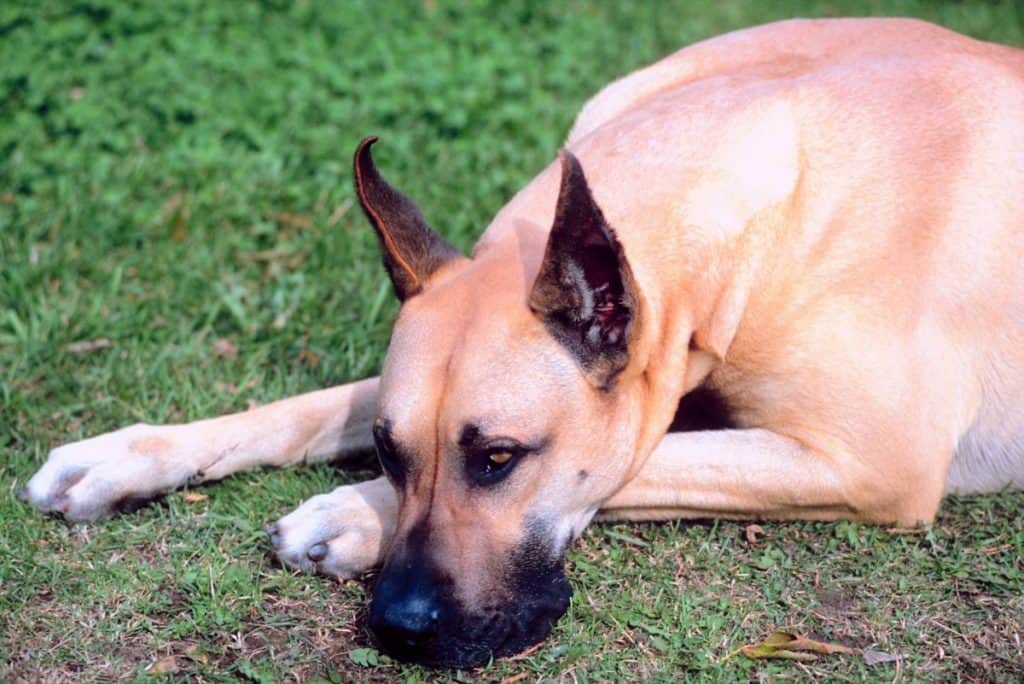
Most dogs (male and female) go home the same day as the surgery once they have recovered from the anesthesia. However, some clinics may require them to stay overnight for further monitoring.
Once they return home it typically takes 18-24 hours for the anesthesia to fully clear their system. During this time they will likely be groggy. It’s best to keep them in a quiet area away from other pets or children.
During this time they may eat less than normal due to nausea symptoms from the anesthesia.
While they may want to resume normal activity after a few days, you need to restrict them for two weeks after surgery. This will allow the surgical incisions to fully heal, and reduce the chance of complications.
You should avoid bathing your Dane during this time as it increases the risk of infection. You should also keep the Elizabethan collar in place through the entirety of the healing process.
This large cone will prevent them from licking or biting at the surgical site that will get itchy during healing. You should inspect the surgical site twice a day to check for any negative changes (as listed below).
Things to Watch For During Recovery
Contact your veterinarian for guidance if you notice any of the following symptoms after the surgery.
- A re-opened incision
- Liquid draining from the incision
- Abnormal swelling around the incision (some is normal)
- Putrid odors coming from the incision as they can be a sign of infection
- Vomiting or diarrhea
- Coughing that persists for more than a couple days post-surgery
Depending on the type of stitches used, they may have to return to the veterinarian between 7-10 days for removal.
Your veterinarian will communicate this step to you upfront. It will take approximately two weeks before they have completely recovered and can return to full play.
This includes activities such as running, jumping, swimming and walking off-leash. While this may seem like a long time, it’s better to be safe than sorry with your beloved Great Dane!
We hope that you found this information helpful. Before you go, make sure to take a look at our favorite products for Great Danes!

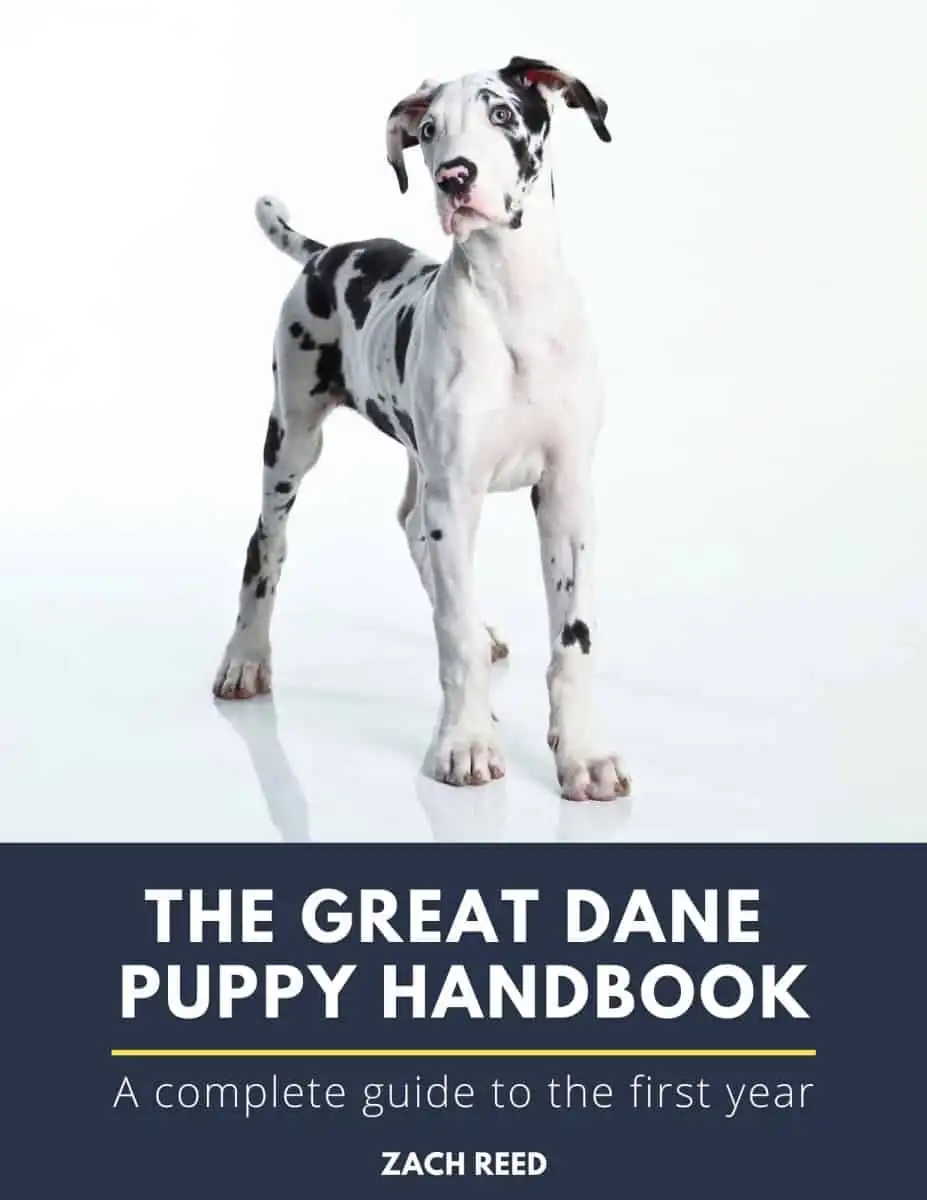


Thanks for the marvelous posting! I actually enjoyed reading it, you could
be a great author. I will ensure that I bookmark your blog and
definitely will come back sometime soon. I want to encourage
continue your great job, have a nice holiday weekend!
I’ve been reading a lot on neutering. I have an almost 9 month old Male. We are trying to wait for a year but he is developing some behaviors we don’t like. From what it sounds like, if we do it now he just won’t bulk up as much. I don’t care so much about appearance. Is the bulking really that important or is he still at risk of developing bad knees and joints if we do it 3 months early?
The risk really boils down to affecting their hormonal balance during an important developmental stage. I’m not sure what kind of behavioral issues you’re dealing with, but perhaps you could help combat them by providing more exercise or working with a trainer to prevent the early neuter operation.
Sarina, It is not just ‘bulking up’ but rather healthy bone growth they are worried about. I did not wait with my females (I didn’t know I was supposed to) and one of them has terrible arthritis. I waited until my male was 20 months. He was getting to be a handful, but IMMEDIATELY after he was neutered, he stopped. He is incredibly sweet tempered and well behaved. My friends and family don’t recognize him! I will never have a Great Dane fixed before they are at least 18 months old. jmho. Good luck with your baby boy
Very well said and good advice Michele. The bone plates need to have time to fully develop or their legs will get a bit too long and they won’t bulk up like they should.
Yes, yes!! All my 9 generation of GD was fixed in 16-17 mo. Old ! And my a new puppy will go the same way. It’s many reasons why!
I’m a new Dane owner. Bella is beyond my heart and joy. She’s 5 yrs old. I thought she was spayed. She is not. I now know cause she’s on her period. Because of her age I’m now afraid of spaying her. I’m pretty convinced at this point not to. Mess oh he’ll yes. But I’d do it in a heart beat to not loose her
I spayed a five year old. I was concerned, but the mess was too much. She laid on the couch for several days, getting up only to eat, drink, and eliminate. She survived, living to age ten.
Do you recommend the preventative gastropexy surgery at time of Spaying a Great Dane?
Yes, that’s the best time if you plan to do it.
Absolutely. Understand, however, gastropexy does NOT prevent bloat but does keep the stomach from torsion (flipping and trapping gas). Make sure you get a vet with experience in this type of surgery. There are two types of surgery for this procedure, very large incision, 9″ or so or laparoscopic, two or three very small holes.
Hi Zach love your channel and really enjoy what you have to say about danes. I’m curious your take on the best time to neuter a male Dane. Google says 6-9 months and the breeder is telling me 16-24 months. I know 6 months has to be way early but the vets always seem to pressure you to neuter early but I know they have so much growing to do. Just wanted your thoughts
I agree with your breeder! Wait until a year and a half at least, better yet 2 years.
Zach, new subscriber here! We Started with Blue’s from a breeder 17 years ago and now only do rescue. We have 3 Danes, 1 Blue Euro Boy(7 yrs), 1 merle Girl(4 years) and one Merlequin(just turned 2) she is partially blind but whew what a handful. Since they were all rescues we only had the opportunity to spay the baby, since we got her when she was 8 months old, and we waited just like you said. The other 2 were done by the rescue before we were allowed to take them. My big boy who is 180 pds was used as a stud to a breeder and then discarded when he stopped throwing off “Ideal pups”. I got him when he was a little over 2 and they neutered him then but he has never forgotten the instinct so when the baby had her heat we had a hard time keeping him off of her, did I mention he is 180 pds! And now every time a dog comes in heat near us he tries relentlessly! Probably no hope for my dear boy but do you have any ideas? He looks a lot like Gus that is why I started watching in the first place and now am hooked! Great Danes Forever!
Is scrotal ablasion (or removal/prevention of ) typical during a male great dane neuter surgery? I did not see anything about it mentioned but my doctor acted like this is typical for large breed dogs and prevents bigger issues later. Thoughts?
PLEASE spay your female Dane or any dog. We don’t need any more dogs in need of homes.
My Dane just came just 5 days of dying. I knew something was wrong. She had a fowl odor for around 6 months. No food allergies. I could not figure it out. The vet guessed urinary tracked infection. Luckily I noticed pus falling from her vagina. Well, she had a life threatening condition called Pyometra (pus fill uterus). She had to have emergency surgery where they promptly spayed her. Odor is gone and she is recovering well. Don’t take this chance on your intact female. If I hadn’t have seen that pus, she would have died within days. Even worse, sometimes they don’t have the discharge and eventually just pass. Please, there are millions of dogs an puppies to adopt. Even great danes. Spay your dog, PLEASE!
Sounds weird, but please describe your female dog’s smell that you smelled. I walked into our living room and it smelled like ‘pee’…yet neither had. Have not seen any puss. But my girlie is giving off a very strong scent…like she was relieved.
We have an 8 month black, male Dane. Very strong Alpha temperament. We have an amazing trainer, but we are noticing more aggression lately, sniffing the ground more, jumping around trying to get off the leash after he rolls in the grass at the park. Also sniffing females at the dog park (we have only been 3 times and go early in the morning), do you recommend not going to the dog park? We were trying to socialize him a bit with other dogs. The article and comments have been so helpful. Waiting two years seems so long, we plan to go 12mths and will try and go a few more. Thank you. Does pet insurance apply to nuetering and the gastropexy surgery? Do you have an Insurance recommendation? AKC Plan?
i have done a lot of research into insurance. and what i have found is insurance covers things like accidents, etc…a wellness plan (usually vets have one available they use) will usually cover things like shots, spay/neuter, heartworm testing, etc and will usually offer a discount( mine is 10%) on other non-covered services like gastropexy. when looking for insurance, definitely check what is covered and excluded. Pet insurance plans are not all equal…cheaper ones may not cover everything you want them to cover, but you may not need everything a more expensive one covers.
Any suggestions as to a comfortable cone of shame or anything I can have on hand to help my dane after surgery? Just trying to prepare for her spaying and wanted to see if anyone had any good tips!
This article was very helpful for me. I have been very stressed about when is the first time. Our vet, not a dane expert, said 6 months and I said no. I see a lot of dane owners saying 18-24 months. Called a local vet with a dane that said a year it fine. I just want what’s best for my year old sisters. So stressful. When did you spay Gus?
I am a first-time Great Dane owner and I found your handbook extremely helpful – thank you! Sadly, my Dane (also Gus!) was neutered at only 8 WEEKS old. I adopted him from a shelter, so it was out of my control.
I am extremely worried about how this will impact his health and lifespan. He is now 18 months old and has the longest legs of any Dane I’ve ever seen. Is there anything I can do to mitigate the issues related to premature neutering? I feed him large puppy food Science Diet and am considering adding Glucosamine supplements to his diet.
He is the sweetest angel ever and I am willing to try anything to increase his chances of a long and healthy life!
After reading this blog I am concerned. I just had my 6 month old Beautiful “Black” Dane spayed per the vet’s advice on breast cancer. My first Dane was also spayed at 6 months, and she was fine, (after surviving Parvo and having Epilepsy all her life) she lived to a ripe old age of 13 yrs old. Now I’m worried about my new girl. She is half Euro and half American and weighs 80.5 lbs at time of surgery. Very heavy bones. Do you think she will be ok?
Our pup (1 year old) has a retained testicle. Our vet has suggested that we have him neutered earlier rather than later because of this. Thoughts?
We are getting a 4-year-old intact purebred male Dane.
Any suggestions on altering him? Is it too late?